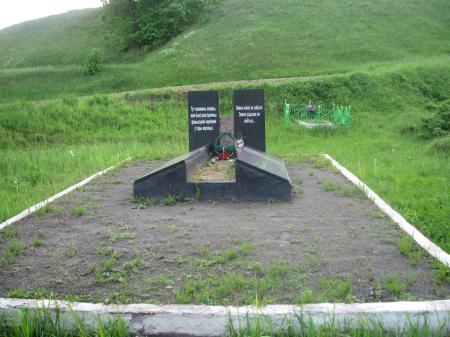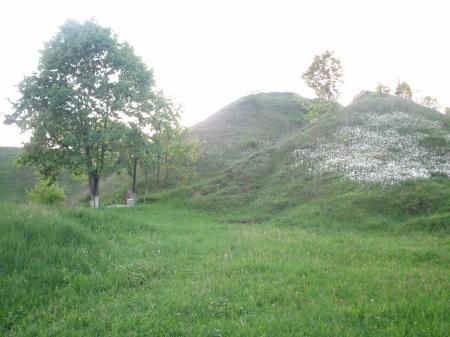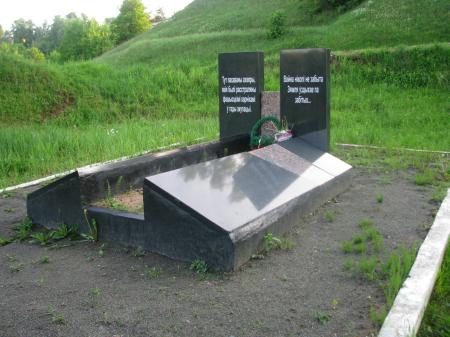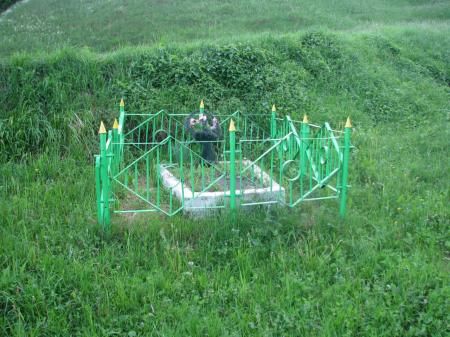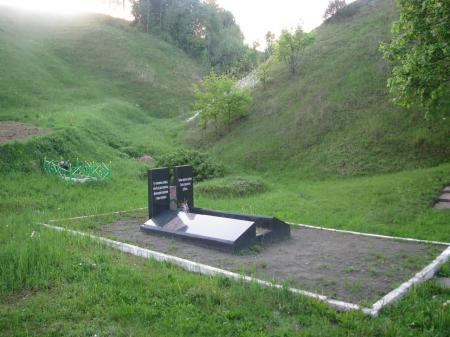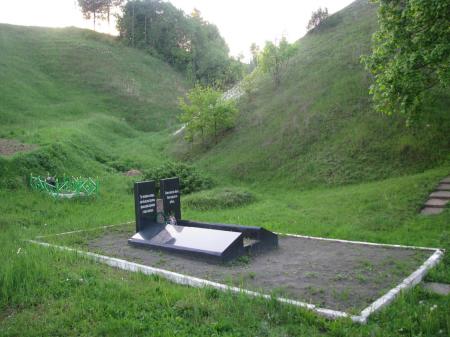Obj. ID: 9390
Jewish Funerary Art New Holocaust Monument at the Killing Site in Mscislaŭ (Mstislavl'), Belarus, 2005
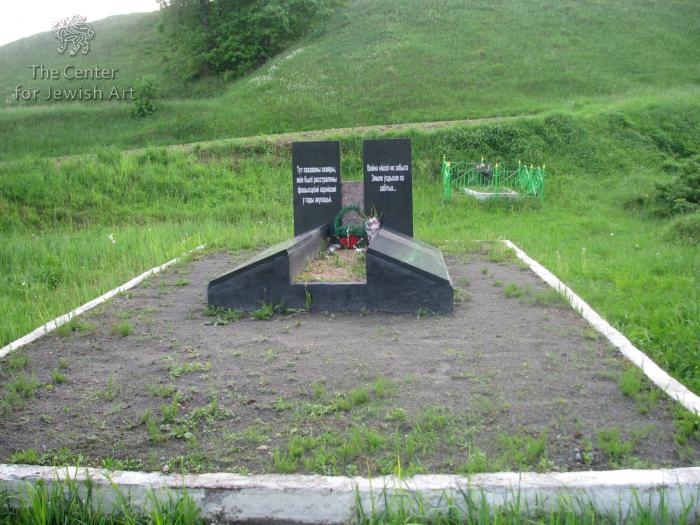
Memorial name
No official name.
Who is Commemorated?
Jewish Holocaust victims from Mscislaŭ (Mstislavl').
Description
The monument is erected at the killing site/mass grave of the Mscislaŭ (Mstislavl') Jews in Kagalnyi Ditch.
The three-partial monument consists of two steles bearing Belarusian inscriptions and a massive section in front of them resembling the form of a mass grave mound. In 2011, on the right section of the stylized mass grave mound, a plaque with a Russian description was added шт 2011.
The monument's territory is surrounded by a low concrete structure.
Inscription
On the right stele:
In Belarusian
Тут пахаваны ахвяры,
якія былі расстраляны
фашысцкімі карнікамі
ў гады акупацыі.
Translation: Here are buried the victims / who were shot to death / by the fascist executioners / during the years of the occupation.
On the left stele:
In Belarusian
Вайна ніколі не забыта
Земля ўздыхае па
забітых...
Translation: The war has never been forgotten, / the earth sighs for / those who murdered.
On the stylized mass grave mound, on the plaque added in 2011:
In Russian
На этом месте
фашистские палачи 15 октября 1941 г.
зверски убили 1300 евреев, а позднее,
в 1941-43г.г. - 168 белорусов и 35 цыган,
в основном женщин, детей и страриков.
Здесь же захоронена группа
советских военнопленых.
Вечная память безвинно погибшим.
Translation: On this side / on October 15, 1941, the fascist executioners / brutally murdered 1300 Jews, and later, / in 1941-43 - 168 Belarusians and 35 Rome persons, / mainly women, children, and the elderly. / The group of Soviet prisoners of war is also buried there. / Eternal memory to the innocently perished.
Commissioned by
The local authorities.
sub-set tree:
The Germans occupied Mscislaŭ (Mstislavl') on July 7, 1941. In September 1941, all local Jews were concentrated in a ghetto [Yad Vashem: The Untold Stories].
The Jews of Mscislaŭ (Mstislavl') were killed by the Germans with the assistance of local policemen in two main murder operations in September and October 1941 [Yad Vashem: The Untold Stories]. The present monument commemorates that of October 15, 1941.
On that day, early in the morning, a group of Germans from Einsatzkommando 8, commanded by Krauze, arrived in Mscislaŭ (Mstislavl'). About 850 Jews of Mstislavl and others who had recently been transported to the town from surrounding villages were collected at the market square of the town. There, Jews were searched, and their valuables and good clothes were taken from them. The men were separated from the women and children. A number of young Jewish women were taken by the policemen to a store and raped. Those who refused to go were killed on the spot. Then, with the assistance of Belarusian policemen, the Germans took all the Jews to the Kagalnyi Ditch, where local Belarusians had dug a pit. When the Jews arrived at the murder site, the Germans had about 30 strong Jewish males expand the pit, and when they had finished this job, they [the diggers] were shot. Then the rest of the Jews, first the men, then the women and children, were made to undress and were shot to death. Those Mscislaŭ (Mstislavl') Jews who were unable to walk by themselves were shot in their homes and their bodies were brought by cart to the same pit. Later Jews who were caught in the area of Mstislavl were also killed at the site. [Yad Vashem: The Untold Stories].
Altogether, on October 15, 1941, 850-1,300 Jews (according to different sources) were murdered [The Map of Holocaust by Bullets: Yahad-In Unum].
In the early post-war years, Jews who returned to Mscislaŭ (Mstislavl') from evacuation, the Red Army, or the partisans erected a small, temporary monument at the Kagalnyi Ditch site. It bore the following Russian inscription: Here the Jewish population of Mstislavl' was brutally shot to death".
This monument was later replaced by one with a short, ethnically neutral inscription in Russian.
In 2005, near it, the present monument was erected by the local authorities. Initially, its inscription did not mention Jews. Only in 2011, an additional plaque, mentioning the Jews as well as Belarusians and Roma people, was added near to monument (Wikipedia).
For the 1965 photograph of the memorial, see: "Svidetel'stvuiut ochevidtsy,"
Moe mestechko / My Shtetl, http://shtetle.com/shtetls_mog/mstislavl/mstislavl_svid.html.
"Getto v Mstislavle,"
Wikipedia, https://ru.wikipedia.org/wiki/Гетто_в_Мстиславле.
"Mstislavl,"
The Map of Holocaust by Bullets, Yahad-In Unum, https://www.yahadmap.org/en/#village/mstislavl-mogilev-belarus.429.
"Mstislavl,"
Untold Stories - Murder Sites of Jews in Occupied Territories of the USSR (Yad Vashem project), https://collections.yadvashem.org/en/untold-stories/community/14621510.


